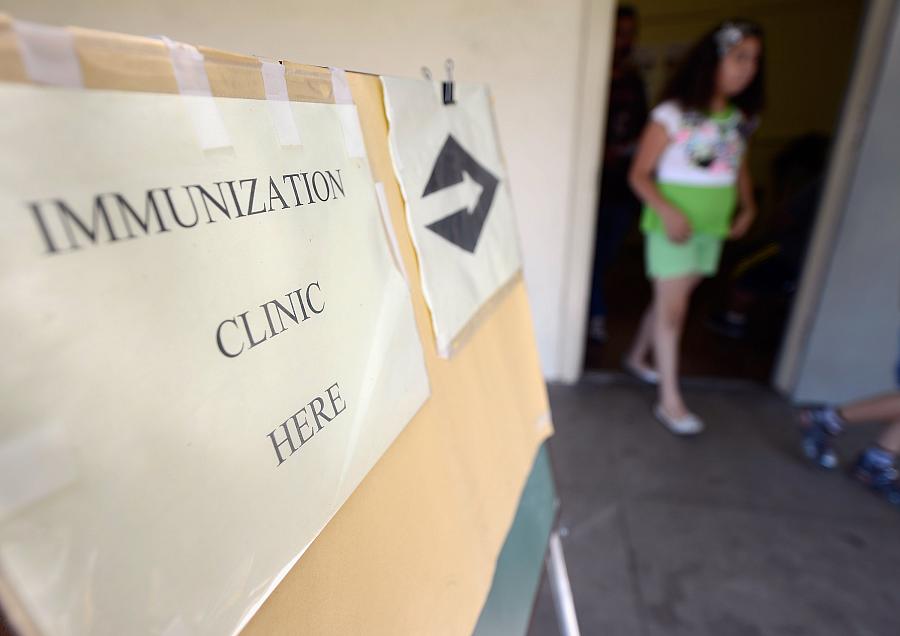Why the battle to bring back school nurses is such a big deal for health and academics

Students leave the school nurse office after receiving a vaccine against whooping cough at Mark Twain Middle School in Los Angeles.
(Photo by Kevork Djansezian/Getty Images)
In the deal struck by teachers and the Los Angeles Unified School District last month, the district committed to having a full-time nurse in every school five days a week by 2020.
That prompts some broader questions: Why are teachers going to the mat to get more nurses in schools? What do nurses have to do with education?
Simply, school nurses help kids stay healthy and in school, and healthier kids learn better.
But in recent years, school nurses across the country have faced layoffs and growing workloads. In LAUSD, less than 20 percent of the district’s 1,147 schools have a full-time nurse. The district employs almost 450 nurses, which translates to one nurse for about 1,400 students — a ratio almost twice as high as recommended by the federal government.
The shortage of nurses can in turn make it harder to learn. Research has shown that a full-time school nurse helps to improve students’ academic achievement, in part due to better attendance. Students with chronic illnesses such as asthma who attend a school with a nurse miss fewer days due to illness, have fewer visits to emergency rooms and result in lower health care costs for their parents. Similar benefits have also been shown for students with other chronic illnesses, including food allergies, diabetes, seizures and mental health problems.
For students with complex conditions, nurses can make the difference between getting to school or not.
Nathalie Fernando, a fellow pediatrician I work with in Long Beach, takes care of a 6-year-old boy whom I’ll call Joey. He has developmental delay, cerebral palsy and limited mobility. He wasn’t able to easily get on the school bus, so he frequently missed first grade.
“I was getting really frustrated with how to help,” Fernando said.
Joey’s single mother didn’t understand how to get him the services he needed. But Fernando was able to connect with Joey’s school nurse, who helped him get support services, including a wheelchair that fit on the bus. Now, Joey regularly attends school, Fernando told me.
Joey is one of a growing number of school-age kids with special health care needs. Nationwide, nearly 27 percent of children and teens have a chronic health condition, with asthma, obesity and attention deficit hyperactivity disorder (ADHD) most common. Seven percent of children have developmental disabilities, according to the Centers for Disease Control and Prevention. The rates of food allergies are also increasing, affecting nearly 8 percent of kids younger than 18.
Youth living in poverty are more at risk for acute and chronic illnesses and they are more likely to have had an adverse childhood experience, such as witnessing violence. The majority of LAUSD students are from low-income families, with 84 percent qualifying for the reduced-cost or free lunch program. Almost three-fourths of the students are Latino. These kids are also less likely to have access to health care.
The physical and mental health needs of LAUSD’s 640,000 pupils are high. More than 10 percent of students receive special education services, at least 20 percent have been exposed to violence and about 63,000 have asthma. A 2013 study showed that nearly one-third of fifth-graders were obese.
Add that all up and the student health needs are huge. School nurses can help students by administering routine medications during school hours, coordinate their care with their primary doctors, offer services such as vision and hearing screening, teach parenting classes for teen moms, and link students to mental health resources. Nurses can also administer first aid to injured students and staff and lead health education programs, such as obesity prevention and sexual health.
In addition, school nurses lessen the workload for teachers and principals. The nurses take care of sick children, develop emergency preparedness plans and handle health-related tasks such as checking vaccine records.
The benefits for students, teachers, staff and the budget have been well known for a long time. The first school nurse, Lina Rogers, began her work in New York City in 1902. She was tasked with reducing absenteeism and identifying children with communicable diseases. After one year, absenteeism decreased by 90 percent, health of the students and the surrounding tenement neighborhoods improved, and the district saved money, according to a review published in 2017 by the American Nurses Association.
Over the past 100 years, research has repeatedly confirmed the benefits of school-based health programs, especially having nurses located on school grounds.
So, why does LAUSD have so few nurses to serve some of Los Angeles neediest kids?
Funding shortages have been a challenge for schools throughout California, as well as nationwide. In California, Proposition 13 passed in 1978 and placed significant limits on property taxes, one of the main sources for revenue for schools. In addition, many California school districts have not recovered from the 2008-09 financial crisis. LAUSD continues to spend more than it takes in. As a result, funding for nurses has been redirected to classroom expenses.
Although those funding challenges won’t be easily solved, the benefits of school nurses in keeping students healthy and ready to learn far outweigh the costs. As a result of the latest agreement between teachers and the district, LA should soon be a welcomed exception to the nationwide trend of the disappearing school nurses.

